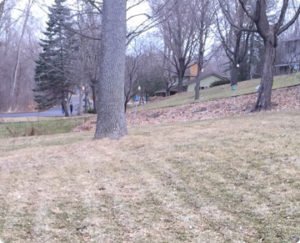Minnesota Homeowner’s Guide to Lawn Fertilization
Fertilizing your lawn may seem like a straightforward concept, but deciding on a proper schedule of when and how much to apply can get tricky when you consider all the variables. That’s why our lawn care experts created this guide to answer some of the most common questions about lawn fertilization and provide Minnesota lawn fertilizer recommendations. Whether you do it yourself or hire the experts at Rainbow Lawncare, this information can help you feel confident in making the best decisions about this fundamental aspect of caring for the lawn you love.

When should I apply fertilizer to my lawn in Minnesota?
The best time to fertilize your lawn, regardless of where you live, is when it is actively growing. In Minnesota, that timeframe can vary a bit; however, a good spring feeding can generally take place in April. After that, fertilizing throughout the growing season will support healthy, even lawn growth and final application can be made in late fall.
How many times a year should I fertilize my lawn?
If using broadcast-spread fertilizer, your best plan in Minnesota will include 4-5 fertilizer treatments. These will occur, generally, in:
- Early spring
- Late spring
- Summer
- Early fall
- Late fall
How do I apply lawn fertilizer myself?
Liquid formulas need to be mixed with water, and can then be sprayed through a special hose attachment. Granular fertilizer can be applied to a recently watered lawn using a spreader, working from the outer edge toward the center of the lawn. Adjust the settings on the applicator according to the product’s instructions. Our experts recommend using slow-releasing granular products, as they have a reduced risk of burning the lawn.
Does lawn fertilizer have to be watered in?
We recommend watering your lawn thoroughly a day or two before applying fertilizer, unless it has rained. Watering lightly after the application can help distribute the fertilizer into the soil.
Should I mow the lawn before applying fertilizer?
Mowing before fertilizing will help the fertilizer reach the soil. Mowing after fertilizing (especially if you bag your clippings) may impact how effective the application is, and reduce the amount of fertilizer that ends up in the soil.
How much fertilizer should I apply?
You should apply fertilizer according to the directions on the package. Well-intentioned homeowners often fall into the trap of thinking “if a little is good, a lot must be great!” However, applying too much fertilizer can burn your lawn and excess fertilizer is carried off in rainwater runoff.
Four additional Minnesota lawn fertilizer recommendations
Fertilization can be a complex process, but it’s one of the best ways to improve the health of your lawn. The experts at Rainbow Lawncare know the best tips and tricks for making the process seamless. When applying fertilizer, there are a few important tips to make sure you get the most out of your efforts.
1. Water your lawn before and after fertilizing
We recommend watering your lawn thoroughly a day or two before applying fertilizer unless Mother Nature has already done so. Watering lightly after the application is also beneficial as it helps distribute the fertilizer into the soil.
2. Start fertilizing on the perimeter of your lawn
The best way to cover the entire lawn is to first go around the perimeter of your lawn. Then, walk back and forth within the perimeter until the entire area is covered.
3. Always remove fertilizer from your driveway and nearby streets
After application, be sure to sweep or blow any granules that landed on solid surfaces back onto your lawn. This will prevent any residual fertilizer from being washed into storm sewers, and keep it out of waterways.
4. Don’t overfeed your grass
Overfeeding your lawn can cause a drying effect, resulting in the grass turning yellow or brown – referred to as fertilizer burn. Be sure to use only the recommended amount!
Why is it important to fertilize my Minnesota lawn?
Your lawn is a big part of your home’s landscape, and it requires ongoing scheduled maintenance. For lush, green grass, it is essential to mow properly, water adequately, and provide missing nutrients through fertilization. Some types of grass are drought tolerant or only need to be mowed a couple of times a year; however, all lawns will benefit from fertilizer service.
Increase plant health with proper nutrition
Grass is a plant that requires adequate nutrients to reach optimal health. Regularly replenishing soil nutrients with fertilizer helps your lawn thrive.
Decrease water run-off
A lawn that becomes thin or patchy due to a lack of nutrients is subject to water run-off during storms. Including fertilizer as part of your regular lawn maintenance routine creates thicker turf that slows stormwater run-off and allows for the soil to retain more water.
Your yard will be less prone to weed infestation
Weeds can thrive in less than optimal soil conditions. A thicker, healthier lawn allows less opportunity for weeds to take hold.

What is the best fertilizer for my lawn?
Fertilizer is available in synthetic formulas made from artificial ingredients, or organic formulas, which are made of living matter such as peat moss or bone meal. Synthetic fertilizers are considered faster acting, but the even, long-term benefits from organic products also achieve great results. Once you decide which you prefer, your next choice will be whether to use a liquid or granular type. Our experts prefer slow-release granular formulations as there is less risk of burning the lawn or damaging surrounding plants or the environment with run-off. Additionally, the blend of primary nutrients – known as NPK – should also be evaluated.
What are the primary nutrients in lawn fertilizer?
The macronutrients in lawn fertilizer are nitrogen, phosphorus, and potassium – also referred to as NPK. Many labels have a series of three numbers, each referring to the ratio of these nutrients in this order. If you are unsure about the ratio your yard may need, you can have a soil test performed or a professional can make recommendations based on an assessment of your yard.
- Nitrogen (N) keeps your lawn lush and green and stimulates growth. Too much results in grass that is too thick and, therefore, more vulnerable to disease and drought stress.
- Phosphorus (P) supports root growth and is usually only needed for new lawns. Because grass takes it up very slowly, it has a greater potential to run off and damage local waterways and lakes.
- Potassium (K) helps grass withstand disease, drought, and cold. It supports the plant’s ability to take up nitrogen and regulates important functions within the plant’s systems.
Minnesota prohibits the use of Phosphorus on lawns unless a soil test indicates a deficiency, or a new lawn is being established. “No P” fertilizers are widely available.
Consider a soil test
Soil tests assess nutrient levels, pH levels, and factors that determine the soil’s ability to retain nutrients. They may also identify problems such as excess salts. Based on these results, the test lab can recommend the best fertilizer for your lawn. Many university extension agencies, including the University of Minnesota Soil Testing Laboratory, offer this service.
Additional lawn fertilization FAQs
A gentle soaking rain can help water-in fertilizer for great results. However, heavy rainfall can wash fertilizer away. Most types of fertilizer will be taken up within two days of being applied.
Some products must be applied to wet grass to ensure that they adhere to the plant. It is best to follow label instructions.
Lawns lacking nitrogen may look yellow or brown. Lawns lacking potassium are less able to fight off damage from disease and drought. Weeds can take over any lawn that becomes thin or patchy.
A well-fertilized lawn will look lush and green. The macronutrient nitrogen is specifically responsible for “greening up” your grass.
Rely on the experts at Rainbow Lawncare for professional lawn fertilization
No other lawn care company does fertilization as we do! Our team of Minnesota experts understands the benefits of lawn fertilization services and can make recommendations that are best suited for your property goals and the current state of your lawn.
Want to make sure your trees are as healthy as your lawn? Rainbow Treecare has you covered.
Other items you may be interested in:

Fertilization
Our fertilization services help you create the lawn you want and ensure it continues to thrive!

Why We Love Our Lawns: A Brief History Of American Lawn Care
America’s love affair with our lawns is as passionate as ever. However, some things have changed—including our image of the ideal lawn. One person’s dream

Spring Lawn Care Checklist for Minnesota Yards
At the first sign of spring in the Minneapolis & St. Paul area, many of us are ready to pounce on our yard and get



